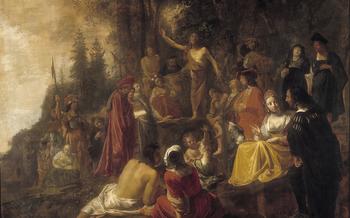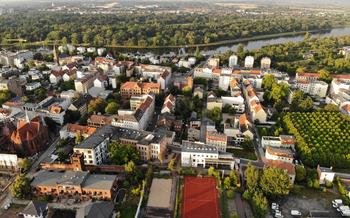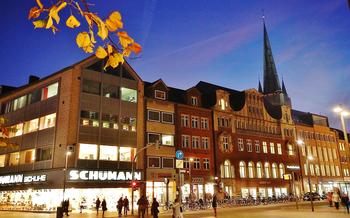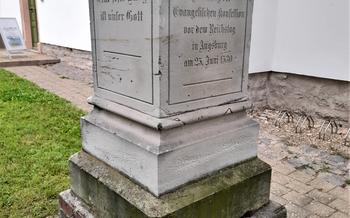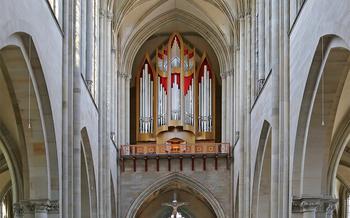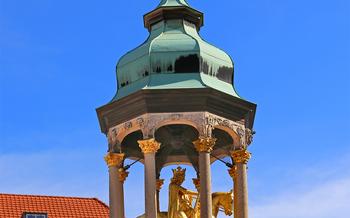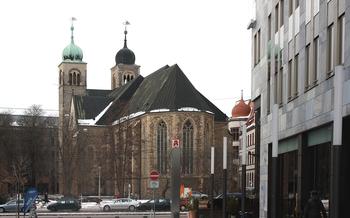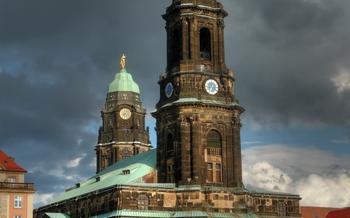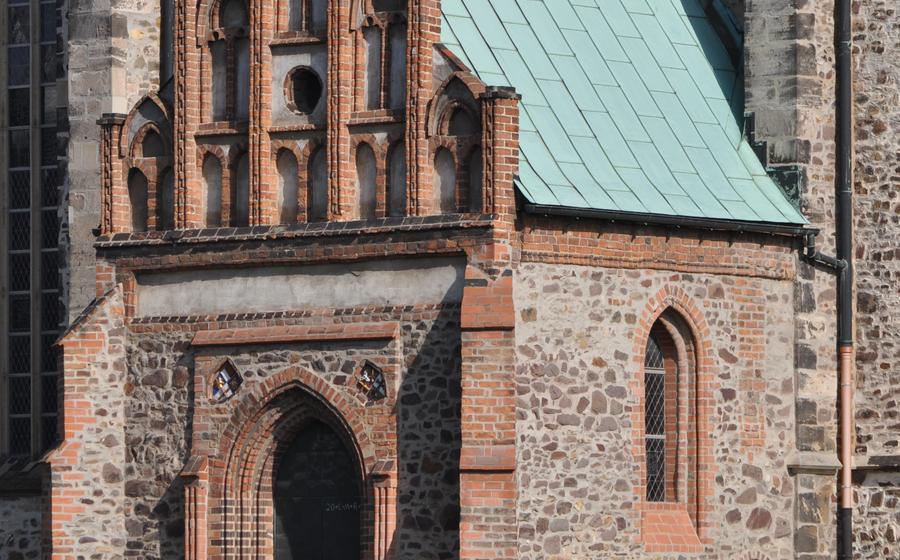
St. Petri Kirche
- Magdeburg: A City Steeped in History
- St. Petri Kirche: A Gothic Masterpiece
- Location and Accessibility
- History and Background
- The Towers
- The Nave
- The Crypt
- Religious Significance
- Guided Tours
- Opening Hours and Admission
- Events and Concerts
- Nearby Attractions
- Practical Tips
- Insider Tip
- Insider Tip:
Magdeburg: A City Steeped in History
Magdeburg, a city in eastern Germany, boasts a rich and varied history that spans over a thousand years. Founded by Charlemagne in 805 AD, it quickly rose to prominence as a trading center, becoming a member of the Hanseatic League, a powerful alliance of merchant cities that dominated trade in the Baltic Sea region during the Middle Ages. Throughout its history, Magdeburg has played a pivotal role in German politics, religion, and culture, leaving behind a legacy of impressive historical landmarks and cultural treasures.
The city's medieval heritage is particularly evident in its charming Old Town, where cobblestone streets, half-timbered houses, and Gothic churches create a unique and atmospheric ambiance. Visitors can wander through this historic district, marveling at the well-preserved architecture and imagining the city's bustling past.
St. Petri Kirche: A Gothic Masterpiece
Architectural style:
St. Petri Kirche is a prime example of Gothic architecture, a style that flourished in Europe during the Middle Ages. Its distinctive features include pointed arches, ribbed vaults, and flying buttresses, which not only provide structural support but also create a sense of height and grandeur. The exterior of the church is adorned with intricate carvings and sculptures, depicting religious scenes and figures, while the interior boasts elegant stained glass windows, intricate wall paintings, and a magnificent altarpiece.
Historical importance:
St. Petri Kirche holds a significant place in Magdeburg's history. It was the first brick church built in the city, marking a departure from the traditional use of stone. The church served as a spiritual and cultural center for centuries, hosting religious ceremonies, community gatherings, and even housing a school. It withstood numerous trials, including fires, wars, and the ravages of time, emerging as a testament to the resilience of the Magdeburg people.
Symbol of Magdeburg:
St. Petri Kirche has become an iconic symbol of Magdeburg, recognized worldwide for its architectural splendor and historical significance. Its twin towers, visible from afar, serve as landmarks and orientation points for visitors and locals alike. The church's distinctive silhouette graces countless postcards, souvenirs, and cityscapes, embodying the rich heritage and cultural identity of Magdeburg.
Location and Accessibility
The St. Petri Kirche stands tall in the heart of Magdeburg, at Breiteweg 194, 3910Its central location makes it easily accessible by various means of transportation.
Public Transportation
Magdeburg boasts an extensive public transportation network that connects the city's attractions seamlessly. To reach St. Petri Kirche, take tram lines 1, 4, 5, and 9 or bus lines 41, 52, and 9Hop off at the "Petriplatz" stop, and you'll find the church right across the street.
Driving Directions
For those arriving by car, Magdeburg's well-connected road network makes it a breeze to reach St. Petri Kirche. From the A2 motorway, take exit 67 (Magdeburg-Zentrum) and follow the signs towards the city center. Continue onto Breiter Weg, and you'll find the church on your right.
Parking
Convenient parking options are available near St. Petri Kirche. The closest parking garage is the "Petriplatz" garage, located just across the street from the church. Alternatively, there are several on-street parking spots in the surrounding area.
History and Background
The founding of St. Petri Kirche dates back to the 11th century when Magdeburg was a thriving city within the Holy Roman Empire. The original church structure was likely a simple Romanesque building, reflecting the architectural style prevalent at the time. However, as the city's influence and wealth grew, so did the ambitions for its religious edifices.
In the 13th century, a major reconstruction and expansion project transformed St. Petri Kirche into the Gothic masterpiece we see today. Skilled masons and craftsmen employed the latest techniques to create a towering structure with intricate details and soaring spires. The church became a symbol of Magdeburg's prosperity and status as a member of the Hanseatic League, a powerful alliance of trading cities that spanned across Northern Europe.
Throughout the centuries, St. Petri Kirche underwent further modifications and renovations, each reflecting the evolving architectural styles and tastes of the time. However, the church's essential Gothic character remained intact, with its pointed arches, ribbed vaults, and flying buttresses continuing to define its majestic appearance.
A significant turning point in the church's history came during World War II, when Magdeburg faced devastating air raids. St. Petri Kirche sustained severe damage, with its roof destroyed, interior gutted, and towers partially collapsed. The church stood as a testament to the destructive power of war and the resilience of the human spirit.
In the aftermath of the war, a remarkable effort was undertaken to restore St. Petri Kirche to its former glory. With meticulous care and attention to detail, skilled craftsmen and architects worked tirelessly to rebuild the church, using original plans and incorporating elements salvaged from the ruins. The restoration project spanned several decades, and the church was finally reconsecrated in 1985, once again becoming a symbol of hope, renewal, and the enduring spirit of Magdeburg.
The Towers
The two towers of St. Petri Kirche are among its most distinctive features. Standing at 99 and 100 meters tall, they dominate the skyline of Magdeburg and offer breathtaking panoramic views of the city and the surrounding countryside. The north tower, known as the "Lange Anna" (Tall Anna), is slightly taller than the south tower, which is called the "Kurze Anna" (Short Anna). Both towers were built in the 14th century and have survived numerous wars and fires.
To reach the top of the towers, visitors must climb a total of 326 steps. The climb is well worth it, however, as the views from the top are truly stunning. On a clear day, visitors can see for miles in every direction. The towers are open to the public during the summer months, and admission is included in the price of a ticket to the church.
The Nave
The nave of St. Petri Kirche is a testament to the grandeur and opulence of Gothic architecture. Its sheer size is awe-inspiring, stretching over 50 meters in length and 20 meters in width. The high altar, a masterpiece of intricate carvings and gilded ornamentation, takes center stage, drawing the eye with its resplendent beauty. The pulpit, an exquisite work of art in its own right, stands tall and proud, a symbol of the church's rich history and enduring faith.
The stained glass windows that adorn the nave are a kaleidoscope of colors, casting a warm and ethereal glow on the interior. Depicting scenes from the Bible and the lives of saints, these magnificent windows serve as a visual testament to the artistry and devotion of the medieval craftsmen who created them. Each window tells a story, inviting visitors to contemplate the deeper meanings and symbolism embedded within the intricate designs.
The Crypt
The crypt of St. Petri Kirche is a treasure trove of history and intrigue. This subterranean chamber, located beneath the choir, offers a glimpse into the past and holds significant historical importance.
Archaeological excavations have uncovered fascinating artifacts, including medieval pottery, coins, and skeletal remains, providing valuable insights into the lives of those who once worshipped in the church. These discoveries have shed light on the daily rituals, customs, and traditions of Magdeburg's early inhabitants.
Today, the crypt serves as a captivating exhibition space, showcasing these archaeological finds and offering visitors a chance to connect with the city's rich history. Interactive displays and informative panels bring the past to life, creating a memorable and educational experience.
Religious Significance
St. Petri Kirche played a pivotal role during the Protestant Reformation. In 1524, the church became a stronghold of Lutheranism, and its pastor, Nikolaus von Amsdorf, was among the first to adopt Martin Luther's teachings. The church served as a meeting place for Protestant reformers, and in 1546, it hosted the Magdeburg Confession, a document outlining the beliefs of the Lutheran faith.
Throughout its history, St. Petri Kirche has remained a vibrant center of Protestant worship. Today, the church is part of the Evangelical Church in Central Germany and hosts regular services, concerts, and events. It is also a popular destination for pilgrims and visitors interested in learning about the history of the Reformation.
In addition to its Protestant heritage, St. Petri Kirche has also been a site of ecumenical dialogue and cooperation. The church has hosted joint events with other Christian denominations, including Catholic and Orthodox churches, and has been involved in interfaith initiatives aimed at promoting understanding and cooperation among different religious communities.
Guided Tours
Guided tours of St. Petri Kirche are available for a more in-depth exploration of its history and architecture. These tours are conducted by knowledgeable guides who provide insights into the church's construction, its role in the Reformation, and its significance as a symbol of Magdeburg. Tours typically last for about an hour and can be arranged in advance or booked on-site. For groups or those seeking a personalized experience, private tours can also be arranged. Reservations can be made through the church's website or by contacting the parish office.
Opening Hours and Admission
Visiting St. Petri Kirche is a delightful and enriching experience that is accessible to all. The church is open to the public from Tuesday to Sunday, allowing visitors to explore its architectural wonders and profound religious history. On weekdays, the opening hours are from 10:00 AM to 5:00 PM, providing ample time for exploration. On Sundays, the church remains open for a shorter duration, from 1:00 PM to 5:00 PM, catering to those who wish to visit after their religious observances.
Admission to the church is free of charge, ensuring that the spiritual and cultural heritage it represents is accessible to all. However, donations are gratefully accepted to support the ongoing maintenance and preservation of this remarkable landmark. For those seeking a deeper understanding of the church's history and significance, guided tours are available at a nominal fee, providing visitors with a comprehensive overview and insights into its unique features.
Events and Concerts
St. Petri Kirche is not only a sacred space but also a vibrant venue for cultural events. Throughout the year, the church hosts a variety of concerts, exhibitions, and other cultural events that attract locals and visitors alike.
Regular events include organ concerts, choral performances, and classical music recitals. These concerts showcase the church's impressive acoustics and provide an opportunity to experience the beauty of sacred music in a stunning setting.
Special concerts and festivals are also held at St. Petri Kirche, featuring renowned musicians and performers from around the world. These events often sell out quickly, so it's advisable to book tickets in advance.
The church's unique atmosphere and historical significance make it an ideal venue for festivals and cultural events. One of the most popular events is the annual Magdeburg Cathedral Music Festival, which brings together choirs and musicians from across the region for a week of concerts and workshops.
Whether you're a music lover, a history buff, or simply looking for a unique cultural experience, St. Petri Kirche is a must-visit destination in Magdeburg. Check the church's website or contact the parish office for more information on upcoming events and concerts.
Nearby Attractions
Beyond St. Petri Kirche, Magdeburg offers a wealth of cultural and historical attractions. A short walk away, the imposing Magdeburg Cathedral, with its distinctive twin towers and Gothic architecture, stands as a testament to the city's rich religious heritage. Step inside to admire the intricate stained glass windows, the grand altar, and the impressive organ.
For a glimpse into Magdeburg's past, visit the Kulturhistorisches Museum, housed in a former monastery. This museum showcases a fascinating collection of artifacts, including archaeological finds, medieval art, and exhibits on the city's industrial history.
If you seek a tranquil escape, head to the Elbauenpark, a sprawling park on the banks of the Elbe River. This idyllic refuge offers a variety of attractions, including a botanical garden, a Japanese garden, and a rose garden. Take a leisurely stroll along the riverbank, admire the vibrant floral displays, or enjoy a picnic surrounded by nature's beauty.
Practical Tips
When visiting St. Petri Kirche, it is essential to be respectful of the religious significance of the place. Appropriate attire is recommended, and visitors should avoid wearing shorts, tank tops, or revealing clothing. Photography is generally allowed, but flash photography is not permitted inside the church. The church is accessible for disabled visitors, with ramps and elevators available.
Insider Tip
To avoid the crowds and have a more intimate experience, visit St. Petri Kirche early in the morning or during the off-season. Pay attention to the hidden architectural details, such as the intricate carvings on the capitals of the columns and the beautiful stained-glass windows depicting scenes from the Bible.
Insider Tip:
-
If you prefer to explore the church without the crowds, plan your visit for a weekday morning.
-
St. Petri Kirche is adorned with intricate carvings, sculptures, and decorative elements. Take the time to admire the details on the exterior facades, especially the intricate carvings adorning the main entrance.
